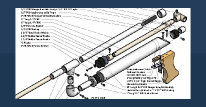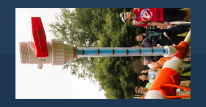Posted 03 February 2004 - 01:47 AM
That actually sounds like a great idea, provided the O-ring keeps it's seal. Wasn't really much of an option on the old guns, with their flimsy rubber cup plunger seals, but could work just fine with a a tire pump. I'm not sure how it would be much better than a normal air gun, since a bike pump's handle is often your average density of steel ('cheep'), as opposed to the plastic plunger's most use. Granted, the mass can be overcome with a really strong spring...
Well, think of it this way. You pull back the plunger, air is drawn into the chamber. You release the plunger, air compresses to a certain limit, until the pressure on the plunger's area exerts a force equal to the force of the spring returning to equilibrium state. At this point, though, that force is relatively low, since the spring is pretty close to equilibrium position (unless you have a rather weak spring, which defeats the purpose), and only a small distance for plunger to travel when "released."
At this point, with the air pressure between the plunger and valve, and spring force equalizing pressure force, you've got two options:
1) Open the valve, let the plunger travel it's sad distance, with less than the pressure of one full pump behind it, and a low spring force creating low velocities due to a large plunger mass.
2) Bring the plunger back again. Assuming a check valve in the plunger itself, this means you can pressurize more air. But this is synonymous to pumping.
I understand your goal, and I think the alternate view offers some perspective, but I don't know if such an equilibrium state will offer a very powerful shot. I don't fully understand why a plunger gun seems like it would operate best at high spring constants and infinitesimally small plunger mass, but that's just due to the changing pressure systems, combined with the viscous friction that I can't yet mathematically describe. I hope you're onto something.
// Here's a thought, for those who are still reading this claptrap: Try a check valve on either side of the pump, both aligned in the same flow direction, and both attached to pressure tanks, so on a downward stroke air is pressurized into one tank, and on an upward stroke air is evacuated from the other tank, creating a vacuum in the other tank. Granted, max pressure is about -31PSI in the one tank, but it could be used for something... It would also make the upstroke of the pump have resistance, but granted a small pump (you know, the ones you usually need to pump 10 times to fully pressurize a tank, wasting more time than energy?), you could make more efficient use of reload time.
Vacuum pressure could be used for firing with an inverse valve system, or assisting the main shot, but that's no fun; You could use it to power onboard functions, such as pistons, for reloading, automatic stock extension, or whatever else you feel like. Just an odd thought. Naturally, you'd need to reroute incoming air once the tank is fully evacuated, so assuming a pump efficient in both directions, you'd need triple the volume of the evacuated tank for a working pressure of about 90PSI in the firing tank. \\
"'Revere me as hot! All others are not! THIS, I COMMAND!'"
- Death
















